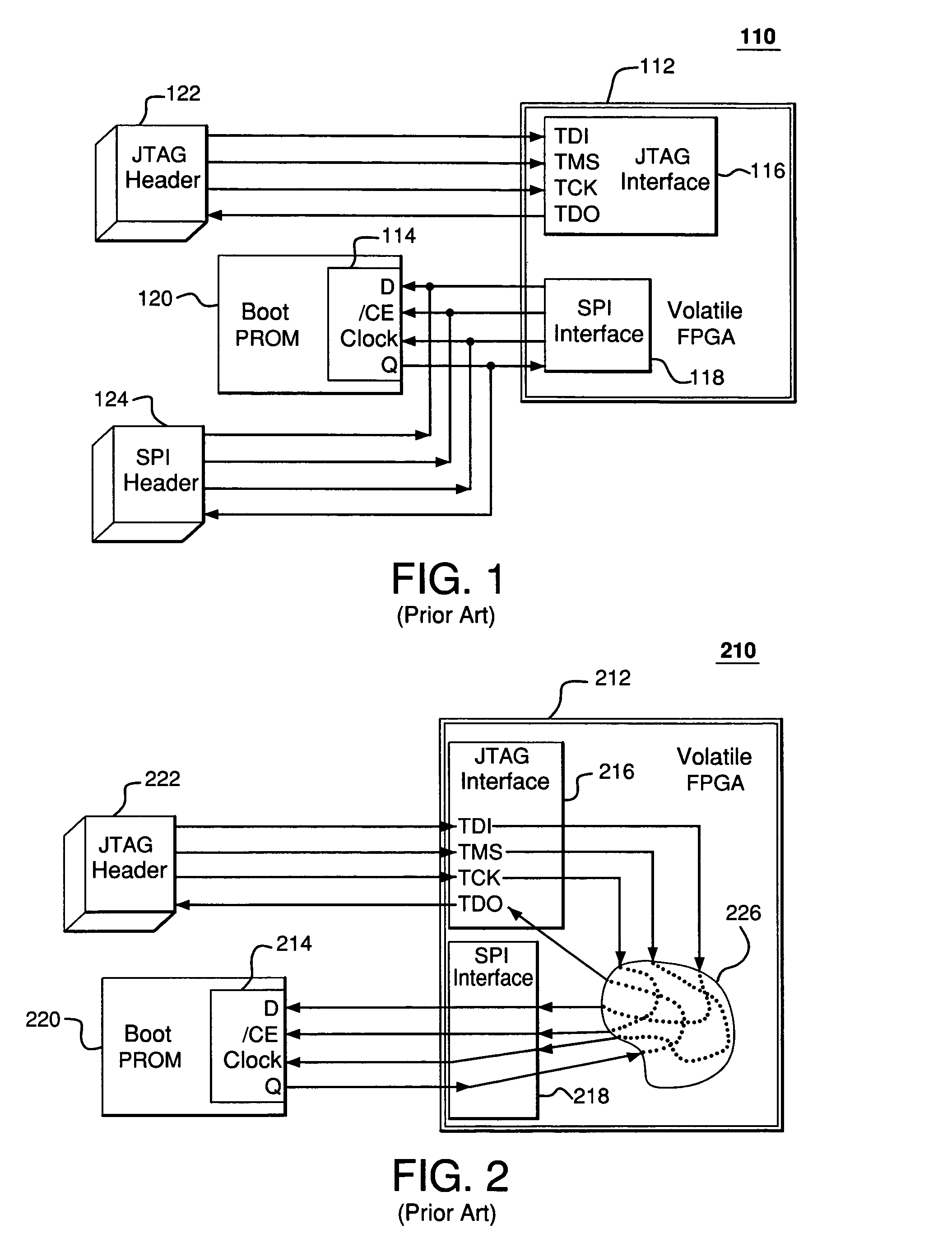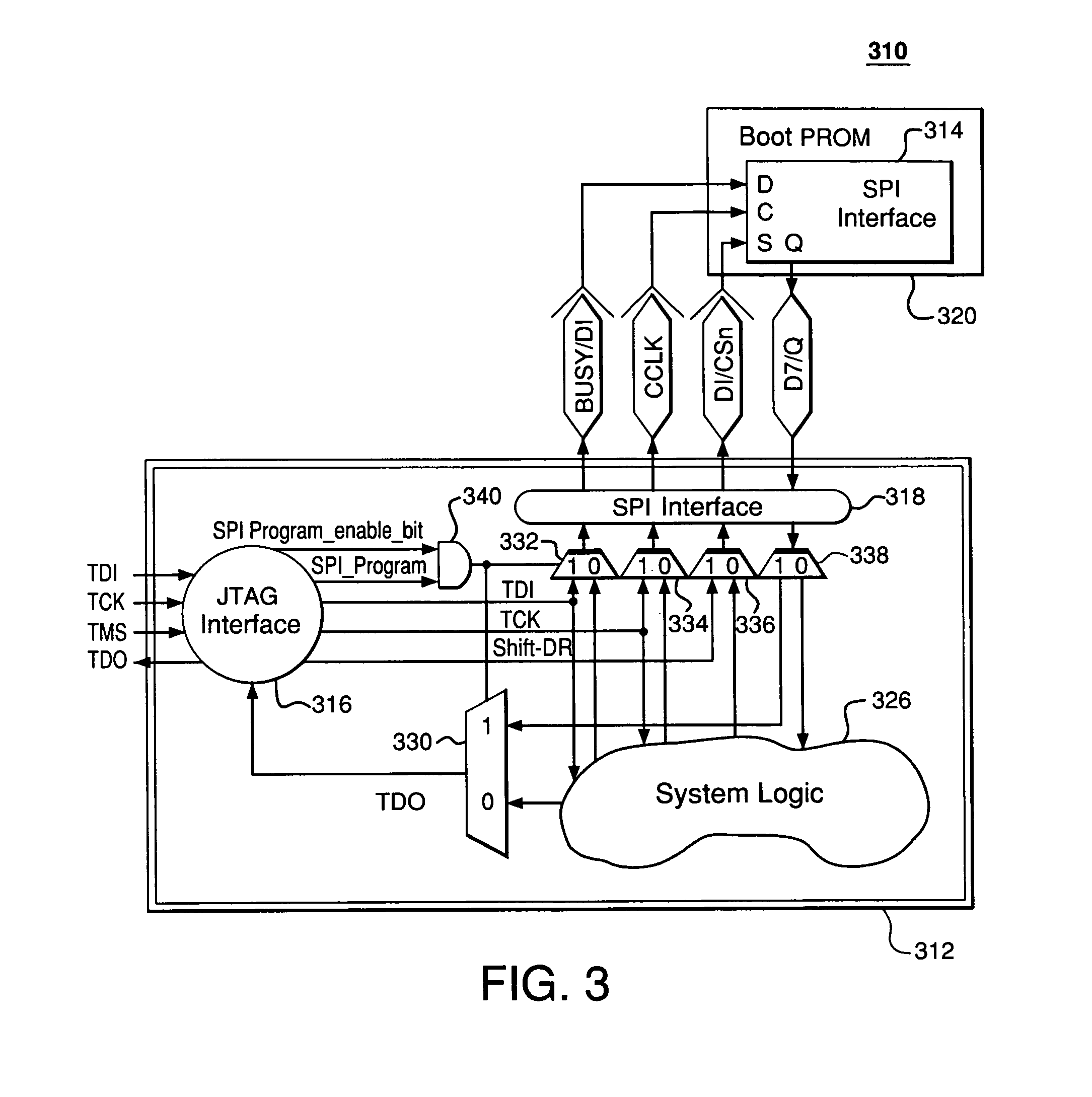In-system programming of non-JTAG device using SPI and JTAG interfaces of FPGA device
a non-jtag device and in-system programming technology, applied in the field ofprogrammable devices, can solve the problems of increasing cost, requiring off-board programming, and occupying board space and fabrication costs
- Summary
- Abstract
- Description
- Claims
- Application Information
AI Technical Summary
Benefits of technology
Problems solved by technology
Method used
Image
Examples
first embodiment
[0020]FIG. 3 shows a block diagram of an exemplary architecture 310 in the present invention, for using an FPGA 312 to program a JTAG-noncompliant boot PROM 320. As shown, in this exemplary embodiment, PROM 320 is a conventional SPI serial flash PROM device that includes a SPI interface 314. FPGA 312 includes a JTAG interface 316, a SPI interface 318, programmable system logic 326, a gate 340, four multiplexers (muxes) 330, 332, 334, 336, and a demultiplexer (demux) 338. JTAG interface 316 connects to a JTAG header (not shown) for attachment to an external JTAG-compliant device (not shown). JTAG interface 316 receives signals TDI, TCK, and TMS from the external device and provides a signal TDO to the external device, which signals are defined as follows:[0021]TDI: Test Data Input signal provided by the external device for supplying one or more of instructions and data from the external device to the registers of JTAG interface 316.[0022]TMS: Test Mode Select signal provided by the e...
second embodiment
[0085]FIG. 6 shows a block diagram of an exemplary architecture 610 in the present invention, for permitting multiple JTAG-noncompliant boot PROMs to be programmed in a daisy-chain formation using a plurality of FPGAs. As shown, this exemplary embodiment includes a JTAG chain of three FPGAs 612-1, 612-2, 612-3 connected to two boot PROMs 620-1, 620-2 at their respective SPI interfaces 614-1, 614-2. For ease of reference, the details of the JTAG and SPI ports of FPGAs 612-1, 612-2 are not shown, since such details are provided in FIG. 3 and its corresponding description above. FPGA 612-3 may be an FPGA consistent with the invention, as shown in FIG. 3, or may, alternatively, be a legacy or conventional FPGA, e.g., as shown in FIG. 1 or 2.
[0086]In this exemplary embodiment, FPGA 612-1 is used to program PROM 620-1, and FPGA 612-2 is used to program PROM 620-2. PROM 620-1 serves as the boot PROM for FPGA 612-1. PROM 620-2 is the boot PROM for both FPGAs 612-2 and 612-3, where FPGA 612-...
PUM
 Login to View More
Login to View More Abstract
Description
Claims
Application Information
 Login to View More
Login to View More - R&D
- Intellectual Property
- Life Sciences
- Materials
- Tech Scout
- Unparalleled Data Quality
- Higher Quality Content
- 60% Fewer Hallucinations
Browse by: Latest US Patents, China's latest patents, Technical Efficacy Thesaurus, Application Domain, Technology Topic, Popular Technical Reports.
© 2025 PatSnap. All rights reserved.Legal|Privacy policy|Modern Slavery Act Transparency Statement|Sitemap|About US| Contact US: help@patsnap.com



